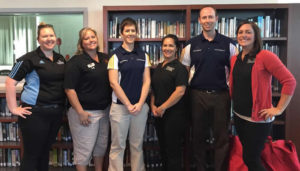San Diego ATs Host Athletes Saving Athletes Event
On March 23rd St. Augustine High School in San Diego hosted an Athletes Saving Athletes (ASA™) program put on by the non-profit organization Advocates for Injured Athletes. The primary goal of the program was to educate high school aged athletes to recognize potentially life threatening injuries.
The program stresses that the athletes recognize the injury and go get help but not to evaluate or treat the injuries. 60 student athletes attended are now ASA™ ambassadors.
They can now educate their peers, and possibly help someone in need. ABC Channel 10 in San Diego was in attendance and did a piece for their 6pm news cast. Also in attendance were Samantha Villa, MS, ATC, Riki Cantieni, DPT, ATC, Jamie Adams MEd, ATC, Christina Scherr MEd, ATC, Kevin Messey, MS, ATC, CSCS, CES, and Adrienne Wilson, MS, ATC.
ASA™ is a program run by Advocates for Injured Athletes, a non-profit organization that promotes student athlete safety. Beth Mallon, and her son, Tommy, Co-founded A4IA after Tommy’s life was saved by his Athletic Trainer, Riki Cantieni, during a high school lacrosse championship game in 2009. He had fractured his C1 vertebrae, and Riki’s evaluation, treatment and stabilization saved his life. A4IA actively lobbies and promotes student athlete safety by advocating for ATs at all high schools in the US, and for legislation that supports youth sport safety.
Since many schools do not have access to an AT, ASA™ was developed to teach athletes to recognize life threatening injuries. ASA™ is a unique 3 hour educational program developed by a team of medical experts and taught exclusively by athletic trainers that covers head and neck injuries, heat illness, sudden cardiac arrest, and hands only CPR/AED training. The motto of the ASA™ is “What you know may save someone you know”.
The primary goal of the program was to educate high school aged athletes to recognize potentially life threatening injuries. The program stresses that the athletes recognize the injury and go get help (not to evaluate or treat the injuries). Examples include: to not move an athlete who may have a head/neck injury and to know where the AED is on campus. Another goal in hosting the event during March included public outreach and education regarding the athletic training profession. CATA liaisons attended the program to record the event and spread the word about who athletic trainers are, and what we do. One major aspect of the profession is to educate athletes and the public about sport safety.
Courtesy of California Athletic Trainers’ Association



Comments are closed